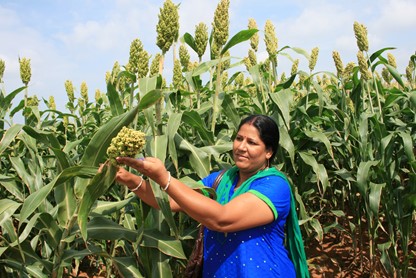Micronutrient-rich sorghum cultivar: ICSR 14001 (Parbhani Shakti)
- From
-
Published on
02.03.22

For robust and responsive global to national breeding systems producing and delivering novel varieties and allied innovations at appropriate scale and scope
What is the profile of micronutrient-rich sorghum cultivar: ICSR 14001 (Parbhani Shakti)?
Sorghum is an important food crop for over 500,000 people in Semi-Arid regions of sub-Saharan Africa and South Asia which harbor the largest number of malnourished people globally. In Asia, predominantly the low-income group populations in India depend on sorghum for their daily calorie intake and meet more than 50% of their requirement for micronutrients from sorghum-based diets. However, the concentration of micronutrients like iron (Fe) and zinc (Zn) in popular sorghum varieties is low (30 ppm Fe and 20 ppm Zn). Therefore, any efforts to increase the grain Fe and Zn contents in sorghum would significantly improve its nutritional value and complement well the ongoing efforts to address micronutrient malnutrition.
The International Crops Research Institute for the Semi-Arid Tropics (ICRISAT) standardized phenotyping methods and assessed over 3,500 germplasm lines, improved breeding lines and hybrid parents in sorghum for their grain Fe and Zn contents, and identified promising lines for use in breeding programs. One of the selected lines from this effort was sorghum restorer line ICSR 14001.
Throughout field performance on-station tests, state multilocation trials in Maharashtra and the All India Coordinated Sorghum Improvement Project (AICSIP), the newly developed sorghum variety Parbhani Shakti consistently produced higher grain yield (up to 3.5 t/ ha). In addition, it also showed higher grain Fe concentration of up to 45 ppm and zinc up to 32 ppm when compared to the baseline of 30 ppm Fe and 20 ppm Zn in sorghum, far superior to the popular cultivars used as checks in these trials.
